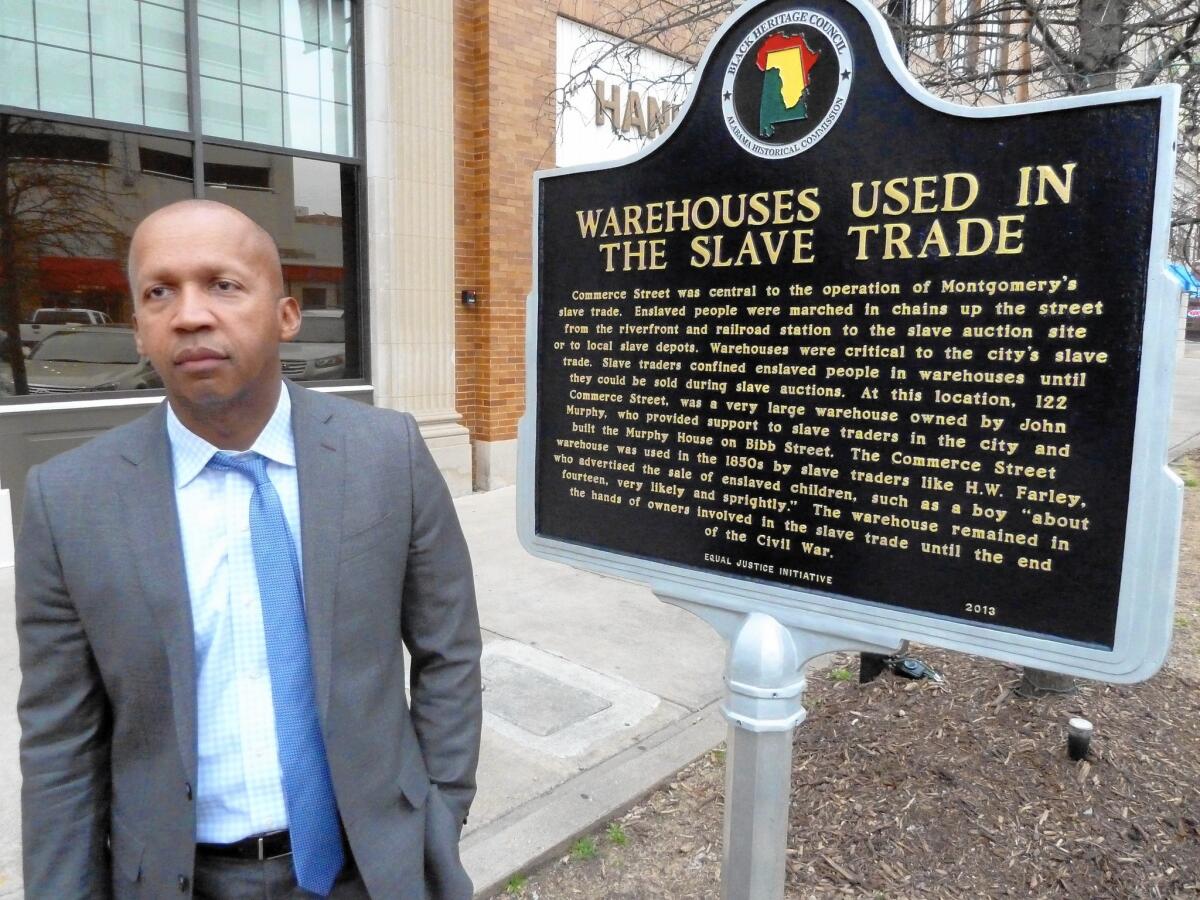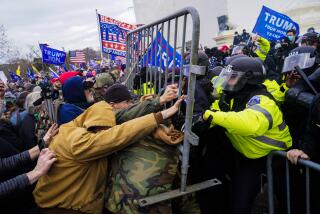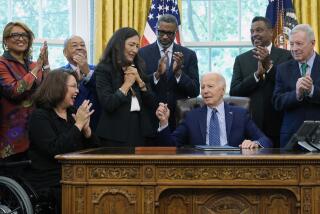Civil rights lawyer seeks to commemorate another side of Southern heritage: Lynchings

- Share via
Reporting from MONTGOMERY, Ala. — Bryan Stevenson was driving to a jailhouse meeting in the morning gloom, through stands of loblolly pines and sweet gum trees, when he spotted the mammoth Confederate flag unfurled along Interstate 65, near a town called Clanton.
He flinched. And looked away: He’d seen the image too many times.
“It’s an insult,” Stevenson, 55, said of the banner at Confederate Memorial Park and Museum. “It evokes memories of how those rebel flags were brought out whenever people started to talk about integration.”
The sight of that blood-red flag also reminded Stevenson of a personal mission: The Harvard-educated lawyer and great-grandson of a slave wants to erect his own civil rights symbols across the South.
His plan is to place memorial markers at lynching sites, where black men, women and children were strung from trees and hanged from telephone poles, sometimes at the rate of one per week, for “offenses” that could be as trivial as playing music too loudly or failing to tip a hat to a white man — or for nothing at all.
Stevenson’s nonprofit Equal Justice Initiative earlier this year released its own accounting of America’s lynching era, documenting 3,959 such incidents of “systematic domestic terrorism” between the end of Reconstruction in 1877 and 1950 — at least 700 more than had been previously reported.
The markers will represent a new kind of memorial in a part of the country that is replete with tributes, such as the flag along Interstate 65, to the Southerners who fought and died for a cause that included the right to hold blacks in slavery. Stevenson’s memorials will each mark the spot where a person died, reminding those in the present of the terrible past — of an event that took place on ground that might now be a shopping mall or a city park.
The plan has taken on new symbolic significance since last month’s fatal shooting of nine African Americans, allegedly by an avowed white supremacist, in a church in Charleston, S.C.
Since then, the Confederate flag flying over the South Carolina statehouse has been under growing attack, with Republican Gov. Nikki Haley reversing her previous stand and calling for its removal. Other Southern memorials, to Confederate officers and even former Ku Klux Klan leaders, have also come under new scrutiny.
“The narrative of racial difference that lynching dramatized continues to haunt us,” initiative leaders said in their report.
For months, Stevenson has sought out officials in towns that are the sites of former lynchings, speaking privately with mayors, making plans to address city councils, to secure support to erect the simple bronze markers. He’s starting in African American communities where he knows his plan will receive easy support, before moving on to other towns where white residents might not want to open up such a painful chapter of the past.
Doug Jones, a former U.S. attorney who led the prosecution of two former KKK members for the 1963 Birmingham church bombing that killed four young girls, says he knows the battles that lie ahead.
“People will say, ‘Why go back to the past?’ Just like they did when we reopened the church bombing prosecution,” he said. “But you never close those chapters, which still sear in the black community.”
Recently, Stevenson successfully lobbied the City Council in the town of Brighton, a black suburb of Montgomery, to mark the 1908 lynching of a black worker there.
His goal is to change the dialogue on race and narrow the gap he is convinced is at the root of conflicts in places like Ferguson, Mo. — attitudes he says date back nearly two centuries.
“There’s still this presumption of guilt assigned to African Americans from people inherently worried about the dangerousness and criminality of black men,” Stevenson said. “It’s a burden. The police have menaced, threatened and followed us all our lives.”
According to the research in the justice initiative’s report, the biggest number of lynchings occurred in Georgia and Mississippi, while the highest rates were in Florida, Mississippi, Arkansas and Alabama.
Blacks were lynched for knocking on a white woman’s door, refusing to remove an Army uniform after World War II and bumping into a white girl while running for a train. Often, Stevenson said, the hangings became public carnivals designed to instill fear.
The spectacles were as vicious as any modern Islamic State video. The report describes one lynching in Dyersburg, Tenn., in which a 24-year-old farmworker accused of raping a white woman had his eyes gouged out and a hot iron poker shoved down his throat before he was castrated and burned alive over a slow fire.
The report avoids showing the so-called “strange fruit” of black men swinging from ropes, images that Stevenson says help perpetuate the insult. A calendar published by his group, highlighting significant dates in the fight for racial equality, instead shows a 1963 image of a female civil rights marcher, crouching as she is pounded by water shot from Birmingham police.
While Germany used public dialogue to come to terms with its Holocaust legacy, Stevenson says, “In America, we do just the opposite.... We don’t want to talk about it; we don’t even want to think about it.”
Raised in rural Delaware, where he felt the effects of racism during the era of Jim Crow, Stevenson has spent his life challenging racial and economic biases in the nation’s criminal justice system, representing people he argues are often imprisoned, in effect, because of their poverty and the color of their skin.
In 30 years, he has argued half a dozen cases before the U.S. Supreme Court. He’s won new rights for convicted children and the mentally ill and has become a powerful advocate for death row inmates, helping overturn the executions of 115 condemned prisoners.
As a young lawyer, he once met civil rights icon Rosa Parks, who made a prophetic observation as he described his life mission of racial equality.
“That’s going to make you tired, tired, tired,” she told him.
So far, the lynching marker project has been slow going. While there has been some support, Stevenson has also met with what he calls “low-level hostile, menacing resistance.”
“What do you want?” one writer asked him, as Stevenson recalls it. “I’ll tell you what you should get: A .357 beside the head.”
Bill Rambo, director of the Confederate Memorial Park and Museum, which hangs the flag on I-65, says Southerners are proud of the banner. As for the markers, he said many whites were lynched, too: “Who’s talking about them?”
But another Birmingham resident, James Knight, said placing the markers at the site of lynchings is an idea whose time has come.
Knight, 73, recently attended a speech Stevenson gave at the city’s Civil Rights Institute. As he waited to meet the lawyer, he told of how a fellow African American friend was once snatched by white men here in the 1950s and castrated in the woods nearby.
He wants a marker on the spot. Said Knight: “I think it’s good to know where we came from.”
Twitter: @jglionna
More to Read
Sign up for Essential California
The most important California stories and recommendations in your inbox every morning.
You may occasionally receive promotional content from the Los Angeles Times.











